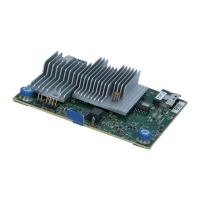SubtopicsSubtopics
Creating a logical driveCreating a logical drive
Creating a profile-based logical driveCreating a profile-based logical drive
Importing secured foreign driveImporting secured foreign drive
Viewing array propertiesViewing array properties
Viewing global spare drivesViewing global spare drives
Making a JBODMaking a JBOD
Making an unconfigured good driveMaking an unconfigured good drive
Clearing a configurationClearing a configuration
Creating a logical driveCreating a logical drive
About this taskAbout this task
WARNING:WARNING: Creating a logical drive will permanently delete any data on an associated drive.
Only Unconfigured Good drives can be used in a logical drive. If you have JBOD drives, you can choose to convert them to Unconfigured Good drives for use in
your logical drive.
ProcedureProcedure
1. From the System Utilities screen, select System Configuration > HPE MRXXX Gen11 > Main Menu > Configuration Management > Create Logical Drive .
2. If you have JBOD drives, they appear in the Create Logical Drive screen. Decide whether you want to convert them to JBOD before proceeding. To proceed
without converting JBOD drives to Unconfigured Good drives, click Skip.
3. In the Create Logical Drive screen, select from the following options.
OptionOption DescriptionDescription
RAID level Depending on the number of drives you have available, select RAID0, RAID1,
RAID5, RAID6, RAID10, RAID50, or RAID60.
Data Integrity Not supported
Select Drives From Enables the physical drive selection option:
Free Capacity uses unused (free) drive capacity that is already part of a
logical drive.
Unconfigured Capacity creates a logical drive on unconfigured drives.
Select Drive View steps here.
Logical Drive Name Name of the logical drive
Logical Drive Size Shows and/or assigns the amount of logical drive storage space. By default, it
assigns the maximum capacity available for the logical drive.
NOTE:NOTE:
Only three decimal places are accepted.
Logical Drive Size Unit Shows the amount of logical drive storage space in megabytes, gigabytes,
and terabytes.
Strip size Selects the strip element size for the logical drive. Drive striping involves
partitioning each drive storage space into strips of different sizes that the
controller firmware supports.
Read cache policy Selects the read cache policy for the logical drive. The read cache policy of a
logical drive determines how the controller handles reads to that logical
drive. Possible settings are:
No read ahead - Specifies that the controller does not use read ahead for
the current logical drive.
Read ahead - Allows the controller to read sequentially ahead of
requested data and store the additional data in cache memory,
anticipating that the data is required soon.
I/O Policy Shows and/or selects the I/O policy for the logical drive. The possible settings
are Direct and Cached.

